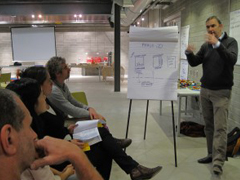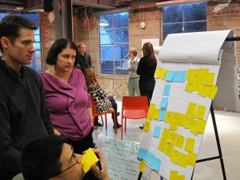Sustainability-driven Collaboration, Part III: Simplicity without reduction, authentic leadership, and process design
 The article Sustainability-driven Collaboration, Part III: Simplicity without reduction, authentic leadership, and process design written by Chad Park, Executive Director of The Natural Step Canada, is the third blog as part of a series that was originally published on the Social Innovation Generation website.
The article Sustainability-driven Collaboration, Part III: Simplicity without reduction, authentic leadership, and process design written by Chad Park, Executive Director of The Natural Step Canada, is the third blog as part of a series that was originally published on the Social Innovation Generation website.
***
In the previous entry in this three-part series on Sustainability-driven Collaboration, I discussed value creation and vision as key drivers of collaboration: how shared and individual value keep collaborators at the table working towards collective goals and how an ambitious, principle-based vision of success (sustainability) can provide creative tension and serve as a powerful driving force for such multi-stakeholder initiatives.
Based on experience and research at the organizational level, I believe that the following three lessons are just as important for improving the capacity of collaborative efforts to achieve transformational systems change towards sustainability.
1. Simplify without reduction – Whether at the scale of individual organizations or in the context of multi-stakeholder collaborative efforts, achieving transformational outcomes in an increasingly complex world requires us to acknowledge and deal with complexity as best we can. Given the multiple competing priorities and dynamics at play even in small organizations, it is true that: “whether building companies, steering governments, or achieving personal goals, avoiding complexity isn’t the answer anymore.”
Simplifying, while not reducing or dismissing complexity, becomes that much more important in multi-stakeholder collaborative contexts. Approaches such as Change Labs have emphasized the need to embrace complexity and use detailed systems mapping and similar practices to identify leverage points for change.
Yet most of us cannot hold complicated systems maps in our heads as we make decisions day to day. Creating systems maps to reveal connections, complexities, and leverage points can be powerful, but individuals and groups can quickly get lost in complexity. Using a systems perspective on an ongoing basis therefore requires simplification without reduction, a process that involves being able to recognize patterns.
For example, the system conditions for sustainability are a useful lens through which individuals and groups can identify patterns that make sense of complicated systems maps about current reality, highlight strategic leverage points, and guide the adaptive processes of trial and error and rapid prototyping that are necessary for innovation.
 2. Demonstrate authentic leadership – The importance of effective leadership is no secret to anyone who has tried to make change happen. For sustainability-driven change in organizations, leaders play an integral role in helping develop shared assumptions and beliefs about the importance of sustainability to long-term success, shared understanding about what sustainability means, and shared language with which to describe sustainability issues.
2. Demonstrate authentic leadership – The importance of effective leadership is no secret to anyone who has tried to make change happen. For sustainability-driven change in organizations, leaders play an integral role in helping develop shared assumptions and beliefs about the importance of sustainability to long-term success, shared understanding about what sustainability means, and shared language with which to describe sustainability issues.
In multi-stakeholder collaboration, authentic and effective leadership is just as crucial. Leaders issue the call to collaborate, frame the narrative of the desired and emerging transformational change, and encourage participants to be comfortable with accepting the emergent and uncertain outcomes that characterize collaboration. Leaders can also visibly model the behaviors so important to collaboration. Baan, Long, and Pearlman, authors of The Lotus, have described 9 personal capacities for transformational leadership. These capacities include having compassion, generating whole system and whole-self awareness, holding paradoxes and ambiguities, and maintaining a sense of humour.
Otto Scharmer’s Theory U: Leading from the Emerging Future provides the definitive word on leadership aimed at transformational change. According to Scharmer, the primary job of leadership is “to enhance the individual and systematic capacity to see, to deeply attend to the reality that people face and enact. Thus the leader’s real work is to help people discover the power of seeing and seeing together.”
3. Design good processes – Sustainability-driven change within organizations doesn’t just happen through compelling words, good indicators, best practices, or even strong leadership. It takes special attention to the social processes that foster creativity, hope, and ambition in this work. Getting people to interact with different people and in different ways than they usually do via carefully designed processes that respect the way adults learn is vitally important for the work to be enduring and the change to be transformational. As explained in Frances Westley, Sean Goebey, and Kirsten Robinson’s Change Lab/Design Lab for Social Innovation, clear processes “are there to provide the direction and put momentum behind a change-making project, not stifle its creativity.”
In a multi-stakeholder context, the importance of clear process is amplified by the absence of any particular unifying organizational structure, the necessity for widely differing viewpoints, and the stronger likelihood of mistrust among individuals. Trust is the most important ingredient for success in a multi-stakeholder collaboration and building trust is the most important process design challenge. Helping people be present and honest, while articulating and respectfully opening up to points of disagreement, requires careful process design and facilitation.
 A lack of clarity in role definition is also an extremely common problem in collaborations. Well-defined processes can help by “providing all participants with a sense of where their workshops are going and how the work they are currently doing, researching, sense-making, or prototyping will fit into broader system change.”
A lack of clarity in role definition is also an extremely common problem in collaborations. Well-defined processes can help by “providing all participants with a sense of where their workshops are going and how the work they are currently doing, researching, sense-making, or prototyping will fit into broader system change.”
Given the challenges, it is no surprise that social innovation labs that offer models on how to actually run collaborative efforts have become so popular. The emphasis of the Lab approach on careful process design, the engagement of diverse stakeholders from across a whole system, and the messy, emergent nature of such endeavors means that Labs tend to require a significant investment of resources and a hefty time commitment from stakeholders.
Advancing the important and emerging practice of Sustainability-driven Collaboration
With all of these lessons and questions in mind, The Natural Step Canada has developed and launched a program called the Sustainability Transition Lab. We aim to blend the lessons that we’ve learned about facilitating transformational change at the organizational level with the best practices that enable change in a multi-stakeholder context.
We think that it is possible to accelerate change in sustainability-driven collaborations by consciously designing the process to build a principle-based vision, shared language, and widespread sustainability literacy among participants. Our bet is that this helps build buy-in and alignment more rapidly and provides helpful design constraints to guide and spur innovation efforts.
In collaboration with a number of partners, we plan to test this hypothesis through a series of projects over the next three years. This effort will itself be an experiment and we will share our learnings – successes, failures, outcomes, and results – as we go.
For more information about the Sustainability Transition Lab, please visit: naturalstep.ca/sustainability-transition-lab.
Want to engage further in the conversation about sustainability-driven collaboration? The Natural Step Canada is excited to host the 2nd annual Accelerate: Collaborating for Sustainability Conference on June 5-6, 2014, in Toronto. Join us to deepen learning about collaboration from experts and practitioners, experience collaboration by creating connections with other change agents, and seed new collaborative initiatives. Learn more and register today!
- Log in to post comments

